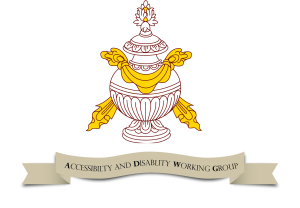Sunday
Mandala ProjectsAccessible Dharma
 A Report from the Accessibility and Disability Working Group
A Report from the Accessibility and Disability Working Group
article compiled by Stefan Carmien, Chair of Accessibility and Disability Working Group
The Accessibility and Disability Working Group of the Office of Societal Health and Well-Being joyously announces its new websites in the Shambhala international network, with Spanish resources here.
In the website we have tried to put together all of the research and results of the activities we have done over the last 12 years. The Office of Societal Health and Well-Being is, besides the evangelist for societal health and well being, also the umbrella for a number of on-going community working groups.
These working groups include: Aging, which connects with and cultivates the inherent wisdom of Shambhala Society in relation to old age; Families and Children works on honoring and supporting the fundamental place of families, children and households in the culture and societal vision of Shambhala; Touching the Earth focuses our efforts in helping Shambhala become a powerful force for societal transformation in accordance with the principles and practices of warriorship and sustainability: and finally Accessibility and Disability works to make our community, its centers, and electronic media accessible to all Shambhalians.
Our group, Accessibility and Disability, works at three levels:
This short article will walk through the list and point out where you can get access to each of the areas we are working in (our previous articles in the Shambhala Times discussed the work we have done with rural practice centers, so this will focus on what is available through the Shambhala website (shambhala.org), and maybe inspire some of you to join in the working group.
Education
Our previous chairperson, Hamish Maclaren, produced an amazing amount of information about disabilities and tools for accessibility. What we have done is distill this information into documents about visual disabilities, motoric disabilities (i.e. difficulty in moving, grasping, sitting), and auditory disabilities. We chose these as they constitute 70% off all incidents of disabilities and plan to offer the same types of documents for other barrier issues in the future.
The documents are of three types:
Along with these we have retained all the original postings of the working group’s forum over the years. Additionally, the wonderful Luz Rodriguez took it upon herself to make Spanish translations of the informative pamphlets. The table below has links, which are also located in the Shambhala website inside the health and wellbeing section.
|
Disability: Mobility |
|
|
Information |
http://shambhala.org/files/2013/02/Introduction-to-Mobility-disabilities.pdf |
|
Spanish information |
http://shambhalanetwork.org/sandbox3/files/2015/01/Mobility_brochure-final_Spanish.pdf |
|
Centre checklist |
http://shambhala.org/files/2013/02/Introduction-to-hearing-disabilities.pdf |
|
Collated resources |
http://shambhalanetwork.org/sandbox3/files/2015/01/Mobility-Resources.pdf |
|
Disability: Visual |
|
|
Information |
http://shambhala.org/files/2013/02/introduction-to-visual-disablities.pdf |
|
Spanish information |
http://shambhalanetwork.org/sandbox3/files/2015/01/brochure-blindness_final_Spanish.pdf |
|
Centre checklist |
http://shambhala.org/files/2013/02/vision-impaired-centre-checklist.pdf |
|
Collated resources |
http://shambhalanetwork.org/sandbox3/files/2015/01/Resources-visual.pdf |
|
Disability: Auditory |
|
|
Information |
http://shambhala.org/files/2013/02/Introduction-to-hearing-disabilities.pdf |
|
Spanish information |
http://shambhalanetwork.org/sandbox3/files/2015/01/Deaf-GTKM-final-V2_Spanish.pdf |
|
Centre checklist |
http://shambhala.org/files/2013/02/Deaf-and-hearing-checklist.pdf |
|
Collated resources |
http://shambhalanetwork.org/sandbox3/files/2015/01/Hearing-and-deaf-resource.pdf |
The accessibility site also has links to large font chant books for centers that wish to provide them as well as a link to getting more information about special material accommodations for advanced programs.
Dharma Material Accessibility
Core to our mission is making the platform that we are using to connect and disseminate the teachings accessible. Accordingly we have created and shared some design guidelines to making accessible webpages, as well as being invited to be part of the design process as the various web offerings are created. Also, our group has gone through the entire set of images in the various sites and adding alt text to the images where it is needed.
Join us!
We are currently looking for new members of the working group. We expect about 12 hours a quarter to work on projects that interest you, as well as attendance at bi-monthly conference calls. Anyone can offer to join in, but in the interest of diversity we are looking for a member who has movement disability, male (we are all female but the chair) and European or South American/Mexican.
You can reach us at: [email protected]





Feb 14, 2015
Reply
That is a great article Stefan. Thanks!
Of related interest are the Shambhala Network groups:
Accessibility and Disability http://shambhalanetwork.org/groups/accessibility-and-disability/forum/ .
and
Captioning and Translating Teaching Videos http://shambhalanetwork.org/groups/captioning-and-translating-teaching-videos/forum/
The Accessibility and Disability group has quite a few good discussions like:
“Meditation with physical challenges and pain” at http://shambhalanetwork.org/groups/accessibility-and-disability/forum/topic/meditation-physical-challanges-and-pain/
“Meditating Lying Down and the “Supine Position”” at http://shambhalanetwork.org/groups/accessibility-and-disability/forum/topic/meditating-lying-down-and-the-“supine-position/
“Meditation and mental illness/extreme emotional situations” at http://shambhalanetwork.org/groups/accessibility-and-disability/forum/topic/meditation-and-mental-illnessextreme-emotional-situations/
“Stories about practitioners living with disabilities” at http://shambhalanetwork.org/groups/accessibility-and-disability/forum/topic/stories-about-practitioners-living-with-disabilities/
“Illness and Disability as Path” at http://shambhalanetwork.org/groups/accessibility-and-disability/forum/topic/illness-and-disability-as-path-1/
Feb 13, 2015
Reply
Hello — I wonder if you have given any thought to the difficulties of those with mental disabilities. If you have, great. If not, think about using the term Physical Disabilities to make it clear who and what problems you are addressing. Yours — Stephen